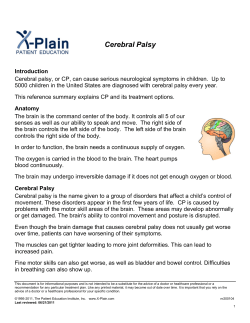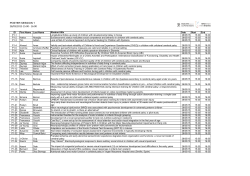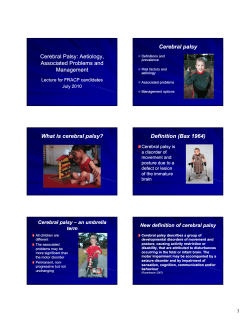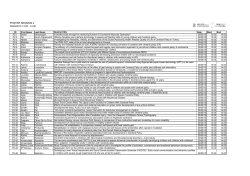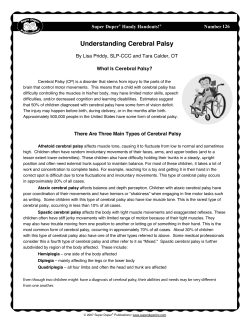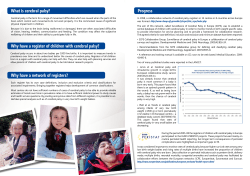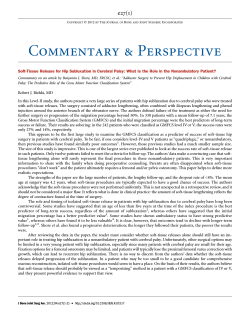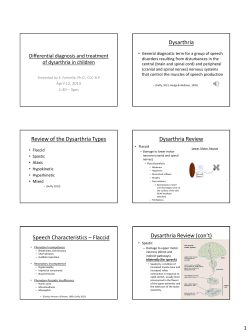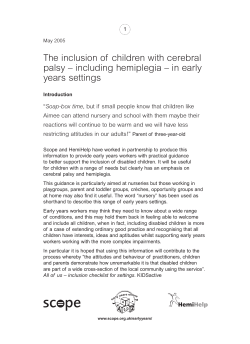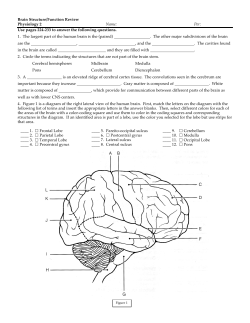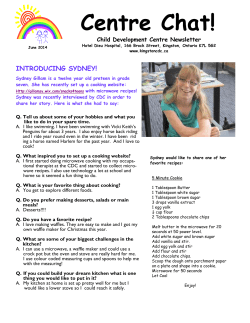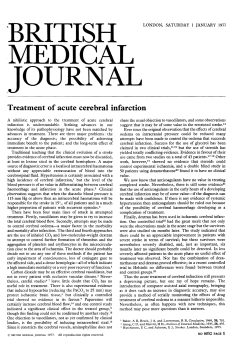
Physical Disabilities
Physical Disabilities Characteristics Physical disabilities include conditions such as cerebral palsy, muscular dystrophy, spina bifida, rheumatoid arthritis, skeletal deformities, and amputations. Chronic health conditions that tend to restrict physical activity, such as heart disease, leukemia, and cystic fibrosis, can also be considered physically disabling. This is by no means an all-inclusive list, but it represents the more common conditions found among children who attend public school. The majority of children with physical disabilities have problems that are exclusively medical and do not interfere with their intellectual abilities. For some, academic progress may be retarded because of excessive absences from school. In the past, architectural barriers prevented many individuals with physical disabilities from attending public schools. They either attended special schools or were taught through homebound programs. Modern architectural and vehicular design, together with new legislation addressing the problems of accessibility to public buildings (Section 504 of the Rehabilitation Act of 1973)n and the education of handicapped children in isolated environments (Education for All Handicapped Children Act, P.L. 94 – 142), has triggered a growing enrollment in public schools of children with physical disabilities. If a child has no learning problems, accommodation in regular classes mainly involves adapting the physical environment. Wider doorways, ramps, handrails, and nonskid floor surfaces should be provided in appropriate locations throughout the school building. The classroom (or music room) should have a flexible room arrangement in order that wheelchairs, which take up more space, can be easily accommodated. Furniture in which seat and desk are all-in-one units is not comfortable or easily managed by the child who ears hip braces. Chairs must be anchored on a nonskid surface or rug so they will securely support a child’s weight when getting in or out of them. The only other consideration for the music room might be the addition of a standing table for the child who needs support while standing. Although commercially available, a standing table can easily be made from any small, sturdy table that is approximately waist high on the child. A semicircular piece is cut from the top front. The child leans into the table, leaving hands free for playing instruments such as Autoharp or resonator bells. The teacher will need to be familiar with the potential mobility and limitations of each child. The best source for this information is the child’s physical therapist. Activities most likely to be affected will be those that utilize gross and fine motor skills. Children with limb impairment should always be included in body movement activities. Even those who come to class in wheelchairs but wear support braces can often stand for short periods of time to participate in a game of dance that requires limited ambulation, such as the Hokey Pokey. Some will also need human support. Braces are sometimes worn to restrict movement rather than support it, and in these cases the range and direction of movement may be limited. Children who regularly walk with the aid of crutches, canes, or a walker can be expected to participate in walking, marching, and simple dance activities, 1 although tempos may need to be slower or the number and complexity of movements reduced. Children who have difficulty in walking often develop undesirable locomotion postures or patterns. If not corrected, these can result in serious deformities. One of the most common is walking on the toes, characteristic of many children who walk with crutches, as well as those in whom one leg tends to drag. Toe walking results in a tightening of the heel cord and eventually it becomes impossible for the heel to make contact with the floor. Correction is ultimately required and is achieved either through braces or by surgical lengthening of the cord. Movement activities that discourage poor posture or locomotion patterns should be constantly utilized. For children lacking mobility, understanding spatial relations is a major goal of movement activities. Small children confined to litters or wheelchairs should be taken out and carried for locomotor activities such as walking or marching, and physically manipulated for activities like swinging and rocking. Research indicates that it is likely a child will never understand that which has not been experienced. Even the child whose body must be moved by someone else will learn through experiencing movement. Obviously a heavier child must have some degree of muscle tone to support body weight. Whenever there is a question as to the advisability of removing a child from a wheelchair, it is wise to seek the advice of someone familiar with the physical condition of the child (e.g., school nurse, physical therapist, parent). The size of the child and the support help available may also determine when it is unwise to remove a nonambulatory child from a chair. Children who are unable to leave wheelchairs can still participate in a good many movement activities. Also, it really is not as difficult to include wheelchairs in singing games and dances as it may first seem. Other than plenty of space, the most common need is someone to push the chairs. The children themselves often have ingenious ideas for adapting the activity to enable the child in a wheelchair to participate. In locomotor activities like running, skipping, and galloping, the child confined to a chair can provide the drumbeat, operate the record player, give auditory signals on an instrument when appropriate, and so forth. "Walking" fingers, a puppet, or other suitable objects are another way to participate. All children learn from watching people move, and the child in a wheelchair, like the others, needs some opportunity to observe the movements of other people. Most often, however, nonambulatory individuals will be participating in some way. Some considerations may have to be made for children in wheelchairs when playing classroom instruments. Lap boards, or tables that are high enough to allow the child to pull the chair up close for playing, will be necessary. However, certain instruments (e.g., larger Orff types) present difficulties for a child in a wheelchair who cannot get close enough at a height that is comfortable for playing. One can often find a solution by positioning and supporting these instruments in different ways. While music activities alone cannot correct physical disabilities, these experiences can help maintain the level of functioning that is achieved through other therapies. Muscles need to be kept functioning as long as possible, even in the dystrophic child. Many activities in music can motivate children to use 2 impaired muscles. Instruments can be positioned so that a child must reach and stretch for them. Music has frequently been the catalyst that motivates a child to use a nonfunctioning extremity. While the physical therapist must often struggle and plead for cooperation, the child often participates enthusiastically in music activities in which the same muscle group is exercised. Singing is very good exercise, too. Many physically handicapped children are susceptible to respiratory ailments, such as pneumonia. Exercising the lungs could be vital for them. Due to the heterogeneity of physically handicapping conditions, a brief description will be given for those most frequently accommodated in public schools. The purpose is to dispel some commonly accepted beliefs that may be erroneous and to clarify implications for teaching music to individuals with physical disabilities. Cerebral Palsy Cerebral palsy accounts for the largest percentage of children with physical disabilities in public schools today. It is a condition resulting from central nervous system damage often caused by a lack of oxygen (anoxia) before,, during, or after birth. There are several types (e.g., spastic, athetoid, ataxic), each having its own distinguishing features, but mixed types in one individual are not uncommon. Cerebral palsy is not paralysis. Muscles lose movement and function because of the inability of the central nervous system to integrate fixed muscle patterns with brain signals. When only part of the signal gets through, abnormal coordination of muscle activity results. Some neurological effects of cerebral palsy are • Delay or arrest in general motor development • Poor head control • Poor balance • Lack of rotation within the body axis • Primary walking patterns • Poor posture control, especially in sitting, standing, and walking • Inability to bring arms forward or overhead • Inability to bring hands together at the midline • Inability to reach, grasp, and manipulate objects • Inability to use arms and hands for support • Tendency of the body to go rigid when voluntary muscle function is attempted Not all individuals will demonstrate all the above effects, but seriously involved children will have several. Cerebral palsy affects an entire side of the body (i.e., hemiplegia). Therefore, if a leg is affected, the upper torso on the same side of the body will also be affected, although perhaps to a lesser degree. It is possible for both sides of the body to be involved (i.e., quadriplegia), but usually to different degrees. Cerebral palsy is a multiply handicapping condition because motor functions are always impaired and are basic to so many other functioning areas. Speech and language are commonly affected. Additional 3 problems may include vision, hearing, perception, cognitive functioning, and seizures. It should be noted that in some individuals, these handicaps are very slight and may not even be noticeable unless pointed out. A large percentage of individuals with cerebral palsy do have difficulties with language development and speech. Often, it is the impaired neurological process in producing and coordinating the speech sounds rather than a cognitive problem that hinders speech. It is wise to talk to them constantly; talk about them only positively when within earshot. Never assume that any individual who doesn't speak also doesn't understand. There is nothing more dehumanizing than having people talk about you as if you weren't even there! Even if speech itself is incomprehensible, the individual can ascertain much about the conversation from body language. The child with cerebral palsy needs activities that will encourage speaking and singing together with movement. Speech chants and rhythmic ostinatos, in addition to songs accompanied by simple instrumental parts or body movement, should be a constant goal. Each motor response should be patterned before introducing objects for manipulation (e.g., instruments, balls, hoops). When neurological processing is impaired, activities that involve combined singing or chanting, playing, and movement must be layered gradually to avoid sensory overload. In other words, each additional component is introduced only when the previous ones are fully assimilated. Difficulties with grasp, eye-hand coordination and balance will be particularly noticeable in music. When a spastic child uses a functional hand (e.g., to play a resonator bell), the affected side of the body tends to stiffen and the head turns involuntarily to the side. This, of course, makes it impossible for the child to look directly at where the hand is aimed. Abnormal muscle coordination also interferes with the child's ability to maintain balance and shift position, even while sitting. Teachers need to be aware of additional problems that can be the result of improper attention to the physical disabilities of the child. Respiration and skin problems, muscle contractions, and brittle bones can result from immobility. Also, when mobility is restricted, environmental interaction is limited, resulting in inadequate sensory development. To lessen the possibilities of these conditions, every teacher needs to learn how to physically handle a child with cerebral palsy in order for that child to receive full benefit from the learning experiences. Being assured that the child will not break at the slightest touch is often necessary for the uninitiated. However, because muscles work in groups, it is easy to activate the wrong ones, which makes handling the child with cerebral palsy a bit tricky. Most importantly, since the type of cerebral palsy (i.e., spastic, athetoid, and so forth) characterizes the type of abnormal muscle functions, proper procedures should be demonstrated by a physical therapist or other person qualified to supervise proper handling of individual children. Muscular Dystrophy Although there are many types of this disease, the most common one is characterized by slow deterioration of the voluntary muscles. Muscular dystrophy usually occurs within the first ten years of life and is more common among boys, but there are types that affect females as well. Falling, clumsiness in walking and climbing, and difficulty in rising from the floor, 4 are early symptoms of the disease. There is a progressive decline in ambulation, during which the child usually walks with the assistance of crutches and braces before being confined to a wheelchair. As the disease progresses, it will also be more noticeably difficult for the child to raise the arms, sit erect, and hold the head up. The individual also fatigues easily. No cognitive deficits are associated with muscular dystrophy. If poor school achievement is a problem, it is more likely to be due to excessive absences from school and fewer demands made upon children to achieve, because of the terminal course of the disease. As in many terminal diseases, there are periods of remission. It is important that muscles be kept functioning as long as possible. Therefore, motor activities that involve the use of both large and small muscles must be a priority as long as the child is capable of executing them. Singing is also healthy for the dystrophic child, since it can help to maintain lung strength and functioning. Children with muscular dystrophy are very susceptible to respiratory ailments, and lack of lung strength could be fatal. As a matter of fact, when muscle deterioration spreads to those muscles necessary to keep heart and respiratory systems functioning, the terminal stage has been reached. In addition, the child will undoubtedly need a good deal of ego support as loss of function increases. Dealing with any handicapped child can be a strain on the emotions if one is unable to keep the performance of professional duty and compassion in proper perspective. Dealing with a terminally ill child, however, is often overwhelming emotionally, especially to those finding themselves in this situation for the first time. It is understandable that parents and teachers frequently overindulge such a child, looking the other way when academic or social standards are not met. However, one should consider the fact that individuals who never have any demands made upon them seldom achieve anything, either personally or academically. Such an individual cannot possibly have a positive self-concept either. A healthy self-image is possible for people with handicapping conditions only when they are expected to do as much as possible for themselves and to put forth appropriate effort in all tasks. Even though life on earth may be brief for some, let us do whatever we can to develop a sense of personal worth and dignity in each individual during the time spent under our influence. Any teacher who finds this philosophy difficult to live with would be well advised to seek counsel from a professional with experience in this area. An old adage expresses this philosophy rather well: "What you think of me I will think of me. What I think of me Will be me!" Spina bifida Spina bifida is a birth defect in which the bones of the spine fail to form completely and cover the spinal cord. Although this condition is frequently accompanied by hydrocephalus, the surgical shunt procedure, when used, now considerably reduces the incidence of retardation that formerly was the inevitable result of that complication. 5 Physical disability among spina bifida children varies from slight to severe paralysis and loss of feeling in the lower body. Incontinence is common and presents both a medical problem and a social one. Urinary infections are a constant threat. Skin or pressure sores resulting from braces or sitting too long are also common because of the lack of feeling in the lower body. Feeling and function in the upper body are usually normal. If there is no hydrocephalus or complications resulting from the shunt procedure, the child with spina bifida will generally have no other learning difficulties that can be associated with this condition. Gross motor activities that take into account the poor ambulation skills of the child should be encouraged. Although ambulation is often laborious, it is important for the child to maintain both motivation and physical energy to become conditioned to it. Without this, independence, and hence individual potential, is doomed. Lack of mobility tends to limit experiences outside the home and with their children. Some children may need extra attention in developing social skills once they enter school. Arthritis Some forms of arthritis are temporary and last only weeks or months. However, chronic and progressively debilitating rheumatoid arthritis is more common in children than many people realize. This type of arthritis attacks the joints of the body but can also involve organs such as the heart, lungs, liver, and spleen. Swelling and stiffening of affected joints is the most common symptom, but inflammation of eyes, skin rash, and stunted growth are sometimes evident, too. Drugs, heat, physical therapy, and aspirin are used to treat the disorder. Splints, braces and casts are sometimes necessary to retard inflammation and keep joints from becoming frozen. There are problems with gross motor skills because the limbs are commonly affected. Fine motor skills will also be poor if joints in the fingers and wrists are affected as well. The range of motion of arms and legs depends upon individual involvement. Visual skills must be continuously monitored, since eye disease is commonly associated with this condition. Every effort should be made to determine if there are physical restrictions placed on the child by the attending physician. Again, it is desirable to keep the joints moving whenever possible. However, a child should never be forced to participate in any motor activities on days when swelling and discomfort are obvious. Epilepsy A great deal of confusion exists about this condition that is caused by an excess of electrical discharge of nerve cells in the brain. Because of the nature of neurological impairments, epilepsy is prevalent among children with brain damage. However, children without neurological dysfunction may also experience epileptic seizures. Often the condition is successfully controlled through medication, and seizures occur infrequently. There are three basic types of seizures. Grand mal is characterized by loss of consciousness, falling, convulsive movements, labored breathing, and drooling. It usually lasts up to several minutes. The child may be confused or drowsy afterward and should be given an opportunity to rest. In contrast, petit mal seizures last only a few seconds, and may not even be recognized by the uninitiated. It may look as if the child is daydreaming or staring off into space. 6 The alert teacher may notice that there is a tendency for the eyes to roll back and the eyelids to twitch or jerk. Some children may have a hundred or more seizures of this type in a day. The child is usually unaware of them and will continue with an activity at the point it was left when the seizure began. Teachers should bear in mind that the child who experiences several of these seizures during a class will likely miss important information and directions. Psychomotor seizures affect both motor and mental functioning. They can last from a few minutes to hours. The child may chew or smack lips, be confused, engage in purposeless activity such as rubbing arms and legs or taking off clothing. They may also experience fear, anger, or rage. Rest afterward is recommended. Many teachers are anxious about having an epileptic child in the class because they fear they will not know what to do in case of a seizure. For those people it may be reassuring to know that there really isn’t much you can do, since the seizure must run its course naturally. The important thing is to keep calm and routinely check the following: 1. Clear the area around the child of people and objects. 2. If the child’s mouth is open, place a soft object, like a handkerchief, between the side teeth, but do not try to force the mouth open. 3. Do not restrain the child’s movements in any way. If this is the first seizure the class has witnessed, it will be necessary to explain to them what epilepsy is, making sure to emphasize that the child isn’t in pain, that seizures aren’t contagious, and that it is a medical problem that occasionally causes a mild inconvenience (like diabetes or an allergy). If this is not the first seizure the child has had in the presence of the class, the children will probably be able to direct you in the above procedures. Allergies Once the allergen is determined, the condition is generally corrected or controlled by diet, medication, and avoiding the allergen. Most children with allergies are not restricted from physical activity in any way, but they may fatigue more easily than other children. Allergy reactions cause sneezing, watering eyes, runny nose, and itching. Asthma has been described as a severe allergy resulting in labored breathing, wheezing, excessive perspiration, and skin pallor during an attack. While asthma attacks are often triggered by allergens, there is some evidence that emotional stress and anxiety can aggravate the condition as well. Most children with asthma fully participate in all school activities, including those that tend to be physically exerting. A child who is experiencing a period of difficult breathing should not be encouraged to participate in music activities requiring physical exertion (e.g., locomotor rhythms) or to play a wind instrument until breathing becomes more natural. Diabetes Diabetes is a condition in which the body is unable to utilize or store sugar. It is treated through diet and insulin. Usually the child with diabetes is not obvious to the teacher because restrictions in activity are seldom necessary. However, there may be an occasional problem with insulin reaction, which is characterized by extreme hunger, excessive perspiration, trembling, and 7 dizziness. Giving the child a carbohydrate (e.g., candy, sugar cube, raisin) will usually clear up the condition in ten to fifteen minutes. Since reactions are more likely to occur immediately before meals, it is a good idea to monitor very strenuous activity during this time. Rarer is the diabetic coma. Symptoms are nausea, vomiting, extreme thirst, and labored breathing. This condition requires that the school nurse be summoned immediately, as an insulin injection is required as soon as possible. Nonfunctional limbs and extremities Some children have limited or loss of function in limbs and extremities as a result of paralysis or neurological impairment. Others are born without limbs, or extremities, or have lost them as a result of injury, infection, or disease. Young children are often fitted with protheses (e.g., artificial arm, hand, foot) during the developmental years and adapt to them quite easily. Yearly adjustments are routine in order to accommodate increasing growth and function. Whenever possible, music experiences should include motor activities that make use of bilateral function in order to prevent the habitual use of the unaffected side of the body. Most classroom instruments are easily adapted for players with one functioning hand. Although some children will use their teeth for holding objects, the child can be offered the assistance of the teacher or classmate for those instruments in which two functioning hands are necessary (e.g., Autoharp). Help should always be offered first and accepted by a handicapped individual, rather than routinely given. Although independent functioning is encouraged whenever possible, children with handicapping conditions need to accept the limitations imposed by their disability and feel comfortable about accepting assistance when it is really needed. Accommodating individuals with nonfunctioning hands and fingers may present some challenges for instrumental music teachers. Appendages (i.e., stumps) are sometimes functional and can do the work of fingers and hands. The best approach is to be “up front” with the child about the disability. If the individual’s choice of instrument seems unrealistic, demonstrate how it is played and then allow the child to experiment with it. Conventional playing position and techniques may have to be compromised. If the child’s heart is set on a specific instrument that appears to be beyond the physical capabilities of the individual, allow the child to try it for a few weeks with the understanding that this is a trial period in which to find out if this instrument is a good choice. If the choice is indeed unrealistic, the child will soon come to realize this and will then be more receptive to alternative suggestions. Meanwhile, seeking solutions, making compromises, and accepting limitations have all served to help the child learn to live with the disability. Many instruments are possible for players with one functioning hand. The piano is one, although published literature for one hand is limited and difficult. Most of this music was written by keyboard composers who wrote etude-type pieces to develop strength and agility in the left hand, which is usually the weakest. They can, of course, be re-fingered for the right hand. Less proficient pianists may find it fun and challenging to arrange simple pieces for one hand themselves. 8 The brass family (i.e., valve instruments) appears to be the best suited to players with fewer than five fingers. The larger instruments can be supported by chair or floor stands for a player with one arm. The slide trombone might be a possibility for an individual lacking enough appendage to push down valves but able to manipulate the slide. The bowed instruments of the string family, as well as folk instruments such as guitar, usually require two functional arms, but they could be handled by an individual with fingers on one hand only. If fingers are only functional on the right hand, the instrument can be strung in reverse (plus adjustment of bridge and soundpost for bowed instruments). The other hand must be able to grasp a bow or strum, however. Woodwinds will probably be the most difficult instruments for individuals lacking some fingers. Even so, they should not be discounted if the individual has functional appendages. In addition to assessing the usual physical attributes of prospective instrumentalists (e.g., mouth formation, finger and arm length), music educators will need to consider the implications of physical disabilities such as finger mobility and strength, range of motion of arms, muscle tone, and lung strength. Although many of these can be developed and maintained through playing instruments, teachers must be willing to help and must also know how to adapt materials and technique appropriately. Multiple Handicaps Previously, even one handicapping condition created problems so overwhelming to educators that not until recently has attention been focused on meeting the educational needs of the child with multiple handicaps. People with multiple handicaps have more than one condition that seriously interferes with functioning and learning. (If one considers language as a handicapping condition, it can be argued that the majority of people with cognitive disabilities, learning disabilities, and hearing impairments are individuals with multiple handicaps.) This population is continually increasing because of advancements in medical science that have saved the lives of seriously injured accident victims as well as infants who would have otherwise been aborted or died at birth. It seems likely that environmental influences that can cause multiple handicaps will continue to increase, so it is imperative that we direct our attention to this segment of the population. Facilities for educating people with multiple handicaps are still sparse. Ideally, educational placement should be decided on the basis of the condition that most affects educational status. However, many times compromises must be made because of lack of programs, medical priorities, and so forth. For example, a child with both orthopedic and sight impairments may be placed in a program for the people with physically disabilities even though, educationally speaking, the more serious problem is vision. Justification for the placement may be lack of a program for children with sight losses that can also accommodate a physical disability, a facility suitable for the people with physically disabilities, or 9 accessibility to physical therapy that is available only to children enrolled in the program for the people with physical handicaps. Children with multiple handicaps lack basic skills in numerous and very specific areas. Their needs as well as their learning styles will have to be assessed and planned for individually, as no generalizations could possibly be made concerning such a diverse population. 10
© Copyright 2025
